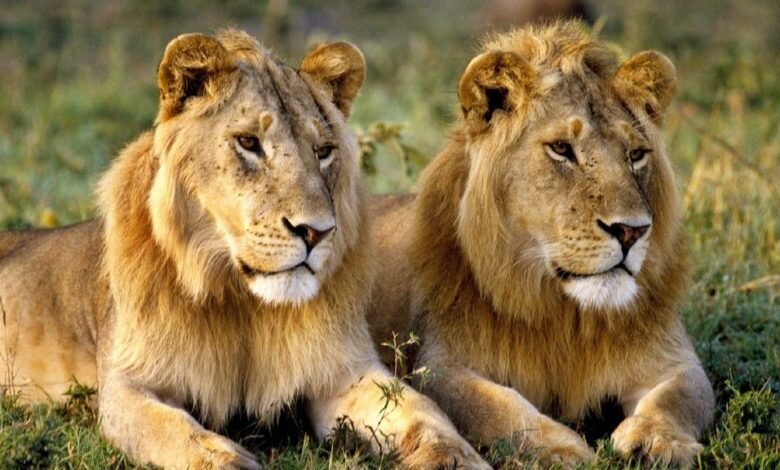Lions: Kings of the Jungle and Legends of the Wild

1. The Basics: What Makes a Lion So Iconic?
When you think of wild animals that command respect, the lion is probably the first one that comes to mind. Lions have long been celebrated in myths, emblems, and popular culture as symbols of strength, courage, and leadership. But what is it exactly that makes them so iconic? It’s not just their roar—though, let’s be honest, that roar is pretty unforgettable.
Physically, lions are built for dominance. The males, with their flowing manes, can weigh over 400 pounds and reach lengths of up to 10 feet including the tail. Their muscular build, powerful jaws, and sharp claws make them top-tier predators. Females, though slightly smaller, are just as impressive. They’re agile, strategic, and often the masterminds behind hunting missions.
But what truly sets lions apart from other big cats is their social structure. Lions are the only truly social cats, living in groups called prides. This pack mentality isn’t just for show—it plays a huge role in their success as hunters and protectors. The dynamic between pride members, especially how they cooperate and defend territory, is fascinating and unlike anything you’ll find in other felines.
2. Inside the Pride: How Lions Live Together
The lion pride is one of the most complex and well-coordinated social systems in the animal kingdom. A typical pride consists of a few adult males, several related females, and their cubs. This family-like structure offers plenty of benefits, from cooperative hunting to shared childcare, and it’s one of the reasons lions are such efficient predators.
Interestingly, while the males are often seen as the leaders because of their intimidating presence, it’s the females that hold the pride together. Lionesses do the majority of the hunting, and they work together with incredible teamwork. You’ll often see them encircling prey, planning ambushes, and taking down animals much larger than themselves—all in perfect sync.
Male lions, on the other hand, have the critical job of protecting the pride. Their thick manes actually serve a purpose beyond aesthetics—they provide protection during fights with rival males. When a new coalition of males takes over a pride, it can lead to intense confrontations, and unfortunately, the loss of cubs as the new males try to establish their dominance. It’s brutal, but it’s nature’s way of ensuring only the strongest genes get passed on.
3. What Do Lions Eat? (Hint: It’s Not Just Zebras)
When it comes to diet, lions are carnivores through and through. Their favorite meals typically include zebras, wildebeests, antelopes, and sometimes even buffalo. These prey animals provide a lot of meat and nutrition for the pride, which is essential since hunting is energy-intensive and often unsuccessful.
What many people don’t realize is that lions are also opportunistic eaters. If they come across a fresh kill made by another predator—or even a weakened animal—they’re not above stealing or scavenging. Hyenas, for example, are often depicted as scavengers, but lions can be just as guilty. In fact, lions and hyenas have a famously antagonistic relationship, often competing fiercely for food.
It’s also worth noting that hunting isn’t a daily occurrence. A successful kill can feed a pride for several days. In between meals, lions do a lot of resting. In fact, they can sleep or lounge for up to 20 hours a day, especially after a big meal. That lazy lion stereotype? It’s not entirely wrong—they really are the couch potatoes of the savannah.
4. Roaring and Ruling: Communication Among Lions
One of the coolest things about lions is how they communicate. That iconic roar isn’t just for scaring off enemies or making dramatic entrances. It actually serves a very practical purpose. A lion’s roar can be heard from up to five miles away and is often used to mark territory or locate pride members in the vast open plains.
But roaring is just one part of a lion’s vocal toolkit. They also grunt, growl, snarl, and meow—yes, meow—to communicate with one another. These sounds convey everything from affection to aggression, and members of a pride quickly learn to read each other’s signals. Cubs, in particular, use soft mews and purrs to interact with their mothers.
Beyond vocalizations, lions rely heavily on body language. A swat with a paw, a flick of the tail, or a gentle head bump can all carry meaning. Grooming is also a huge part of pride life. You’ll often see lions licking and rubbing against one another, which helps strengthen bonds and maintain the social structure. It’s these complex interactions that make watching lions in the wild so captivating.
5. Threats Facing Lions Today—and What’s Being Done
As majestic as lions are, they’re not invincible. In fact, their populations have been steadily declining over the past century due to a variety of human-related threats. Habitat loss, conflict with livestock farmers, and poaching are some of the biggest issues. Lions need large territories to thrive, and as human settlements expand, those territories shrink—fast.
Another major issue is trophy hunting. While it’s controversial, some countries still allow lions to be hunted for sport, arguing that the revenue supports conservation. The ethics and effectiveness of that are widely debated, but what’s clear is that every lion lost puts more pressure on already fragile populations. Add in diseases and climate change, and you’ve got a long list of challenges facing the species.
Thankfully, there’s hope. Conservation organizations around the world are working hard to protect lion habitats, educate communities, and promote coexistence. Eco-tourism is also playing a big role. When local communities see the economic value in keeping lions alive and thriving, everyone benefits. The fight to save lions is far from over, but with global support, we can keep the roar echoing for generations to come.
Final Thoughts: Lions Deserve Their Crown
Lions aren’t just impressive because of their size or power. They’re deeply social, incredibly intelligent, and crucial to the ecosystems they inhabit. Watching a pride interact, hunt, or simply lounge in the sun is an unforgettable experience that reminds us how wild and wonderful the natural world really is.
The nickname “king of the jungle” isn’t technically accurate (since lions don’t live in jungles), but the sentiment behind it holds up. Lions rule wherever they roam, and they’ve earned that title not just through brute strength, but through complex behavior, deep family bonds, and a commanding presence.
Whether you’re a wildlife enthusiast, a casual animal lover, or someone who’s only seen lions in movies or zoos, there’s always more to learn and appreciate about these incredible creatures. And the more we understand them, the better equipped we are to protect them.



